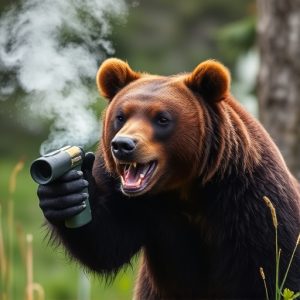Mastering Quick Draw: Optimal Bear Spray Range and Safety
Bear spray holsters offer quick access during aggressive bear encounters, with optimal spray distrib…….
Bear spray holsters offer quick access during aggressive bear encounters, with optimal spray distribution at 20-30 feet (6-9 meters). Misconceptions about the effective range should be avoided; research confirms this shorter distance. Users should prioritize swift draw and aim for the bear's face. Waist or belt-mounted designs enhance accessibility. Understanding bear behavior, local regulations, and training in spray deployment techniques are crucial for safe navigation in bear country.
In bear country, knowing how to deploy bear spray effectively can be a matter of life and death. This guide delves into the crucial aspects of bear spray holster design and quick draw access, highlighting key factors that influence optimal distance for maximum effectiveness. We debunk myths about the range of bear spray and provide practical tips for safe usage during encounters. Additionally, we explore safety considerations and training to ensure you’re prepared when facing a grizzly.
- Understanding Bear Spray Holster Design and Functionality
- Factors Affecting the Best Distance for Bear Spray Use
- Effective Range of Bear Spray: Myth vs. Reality
- Tips for Quick Draw Access During a Bear Encounter
- Safety Considerations and Training for Optimal Bear Spray Performance
Understanding Bear Spray Holster Design and Functionality
Bear spray holsters are designed with a specific purpose: to provide quick and easy access to bear spray during encounters with aggressive bears. These holsters typically feature a secure yet easily accessible compartment for the spray can, ensuring it’s ready when needed. The design often includes a belt clip or strap for convenient carrying, allowing users to keep their hands free while still being prepared.
The functionality of these holsters revolves around optimal spray distribution and ease of use. To achieve maximum effectiveness, it’s crucial to understand the best distance for bear spray deployment. Studies suggest that the ideal range is approximately 20-30 feet (6-9 meters), allowing users enough time to activate the spray and create a protective barrier between them and the bear without being in close proximity, which could be dangerous.
Factors Affecting the Best Distance for Bear Spray Use
When considering the best distance for bear spray effectiveness, several factors come into play. The primary consideration is the proximity to the bear and its behavior. Bear spray is designed to create a barrier between you and the bear, disorienting it long enough to enable a safe escape. Experts recommend using bear spray from a distance of around 20 to 30 feet (6 to 9 meters) when encountering a grizzly or black bear. This range allows for optimal coverage of the bear’s face and eyes while maintaining enough space to assess the situation and take further actions if needed.
The terrain, visibility, and wind conditions also significantly affect the spray’s reach and effectiveness. Rough terrain or dense vegetation can disrupt the spray’s path, reducing its impact on the bear. Good visibility ensures that you accurately gauge the distance and target the bear effectively. Conversely, strong winds can carry the spray away from the bear, making it less reliable. Understanding these factors is crucial for responsible bear spray use and ensuring maximum effectiveness during encounters in the wild.
Effective Range of Bear Spray: Myth vs. Reality
Many outdoor enthusiasts and survivalists believe that bear spray is a foolproof defense against aggressive bears, but there’s a significant misconception regarding its effective range. While bear spray can be a powerful deterrent when used correctly, the idea that it’s effective from a distance of 50 to 100 feet (15 to 30 meters) is largely a myth. In reality, bear spray works best within a much closer range. The optimal distance for maximum effectiveness is typically between 20 to 30 feet (6 to 9 meters). Beyond this range, the spray’s fine mist may not reach the bear’s eyes and face, making it less likely to cause the desired effect of disorienting or deterring the animal.
Understanding the best distance for bear spray effectiveness is crucial for safe outdoor adventures in bear country. Research suggests that bears can detect and react to the scent and spray even at close range. Therefore, users should focus on quick draw access and aim directly for the bear’s face if an encounter occurs. This knowledge allows individuals to make informed decisions about their safety and empowers them to navigate potentially dangerous situations more effectively.
Tips for Quick Draw Access During a Bear Encounter
During a bear encounter, quick draw access to your bear spray is crucial for effective deterrence and safety. The best distance for bear spray effectiveness ranges from 20 to 30 feet (6 to 9 meters). At this range, you can aim for the bear’s face and eyes, which are sensitive areas. Practice your aiming skills regularly to ensure you can accurately deploy the spray within this optimal distance.
To enhance quick draw access, keep your bear spray holster conveniently placed and easily accessible. Consider wearing it on your waist or using a belt-mounted design that allows for swift retrieval. Additionally, familiarize yourself with the spray’s mechanics—knowing how to activate it under pressure will make a significant difference in a real encounter.
Safety Considerations and Training for Optimal Bear Spray Performance
When it comes to bear spray, understanding safety considerations and proper training is paramount for optimal performance in potentially dangerous situations. The best distance for bear spray effectiveness typically ranges between 20 to 30 feet (6 to 9 meters), but factors like wind, terrain, and the bear’s behavior can significantly impact this range. Training should focus on developing a consistent and reliable technique for drawing and deploying the spray, ensuring that users can access it quickly when needed. Practice in controlled environments allows individuals to familiarize themselves with the holster design, the draw mechanism, and the spray pattern, enhancing their ability to respond calmly under stress.
Additionally, learning about bear behavior and local regulations is essential. Understanding when and where bears are most active helps in determining the need for bear spray as a preventive measure. Following safety guidelines, such as making noise to avoid surprising bears or knowing how to react if attacked, should complement training in using bear spray effectively. This holistic approach ensures that individuals not only know how to use the spray but also understand the broader context of bear safety.
When it comes to self-defense against bears, understanding the best distance for bear spray effectiveness is key. By mastering the quick draw access techniques discussed in this article, along with proper safety considerations and training, individuals can significantly increase their chances of deterring an attack and ensuring their survival in bear country. Remember, knowledge is power, and being prepared can make all the difference during a potential encounter. Stay informed, practice, and always carry your bear spray responsibly to ensure its optimal performance when needed most.


